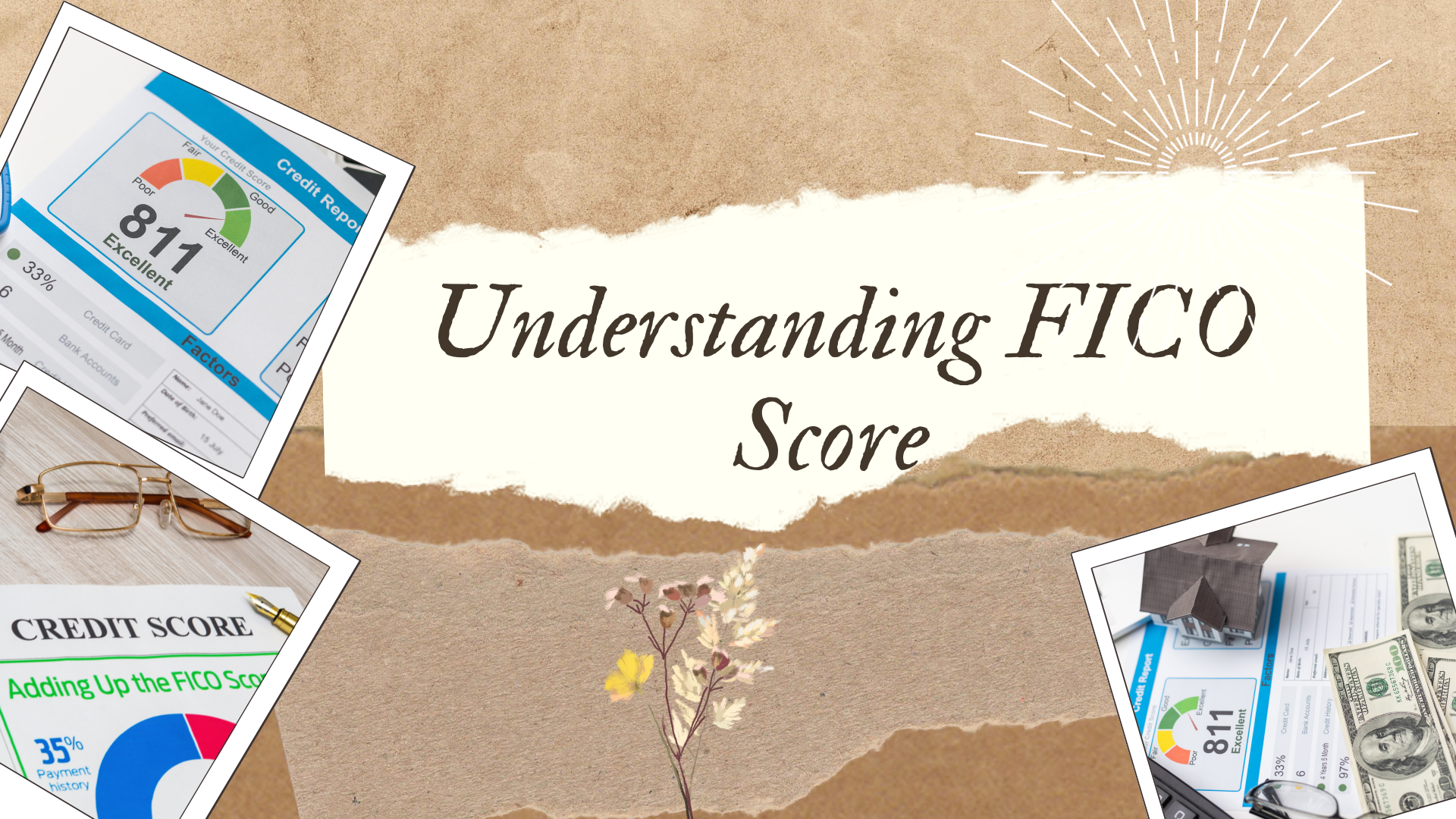Understanding FICO Score

 The FICO score is a credit score used by lenders to assess your creditworthiness, essentially how likely you are to repay borrowed money. It’s named after the company that developed it, Fair Isaac Corporation.
The FICO score is a credit score used by lenders to assess your creditworthiness, essentially how likely you are to repay borrowed money. It’s named after the company that developed it, Fair Isaac Corporation.
The score typically ranges from 300 to 850, with higher scores indicating better credit health. Here’s a general breakdown of what the ranges might mean:
– 300-579: Poor
– 580-669: Fair
– 670-739: Good
– 740-799: Very Good
– 800-850: Excellent
Several factors contribute to your FICO score:
1. Payment History:
– It has a significant impact (about 35%) and focuses on whether you’ve paid past credit accounts on time.
2. Credit Utilization:
– This is the amount of credit you’re using compared to your total available credit. It’s ideal to keep this below 30%.
3. Length of Credit History:
– A longer credit history can positively impact your score.
4. New Credit:
– Opening multiple new credit accounts in a short period may negatively impact your score.
5. Credit Mix:
– Having a mix of different types of credit (like credit cards, loans, etc.) can be beneficial.
Your FICO score is crucial when applying for loans or credit cards. Lenders use it to determine interest rates, loan amounts, and whether you qualify for credit. It’s important to regularly check your score, understand what affects it, and work on improving it if needed.
How to Improve Credit Score?
Improving your credit score involves consistent, responsible financial habits. Here are some effective ways to boost your credit score:
1. Pay Bills on Time:
– Your payment history significantly influences your score. Aim to pay all bills by their due dates.
2. Reduce Credit Card Balances:
– Lowering your credit card balances, especially keeping them below 30% of your credit limit, can positively impact your score.
3. Limit New Credit Applications:
– Applying for multiple new credit accounts within a short period can lower your score. Be selective and avoid unnecessary applications.
4. Maintain a Mix of Credit:
– Having a mix of credit types (credit cards, loans, etc.) can positively affect your score. However, don’t open accounts just for the sake of variety.
5. Regularly Check Your Credit Report:
– Look for errors or inaccuracies that might be negatively affecting your score. Dispute any discrepancies with the credit bureaus.
6. Keep Old Accounts Open:
– The length of your credit history matters. Keeping older accounts open (even if they’re not actively used) can positively impact your score.
7. Use Credit Responsibly:
– Use credit cards but manage them wisely. Make small purchases and pay them off in full each month to demonstrate responsible credit use.
8. Consider a Secured Credit Card:
– If you’re trying to build credit or recover from poor credit, a secured credit card—with a deposit that becomes your credit limit—can be a good starting point.
9. Be Patient and Consistent:
– Improving your credit score takes time. Consistently practicing good credit habits will gradually raise your score.
Remember, the key is to demonstrate responsible financial behavior over time. There’s no quick fix for a low credit score, but these strategies can help you steadily improve it.
HOA Disclosures


When reviewing HOA (Homeowners Association) disclosures while preparing to sell or buy a unit, you can expect several documents that provide crucial information about the property and the association. These typically include:
1. CC&Rs (Covenants, Conditions, and Restrictions):
– These are the rules and regulations that govern the community. They outline what residents can and cannot do regarding property use, alterations, maintenance, etc. The CC&Rs cover various aspects of property use, including rules about architectural modifications, landscaping, noise restrictions, pet policies, parking regulations, and more. They detail what homeowners can and cannot do within the community and are legally binding for all residents.
2. Bylaws:
– These detail how the HOA operates, including board member elections, meetings, voting procedures, and other governance-related matters.
3. Financial Documents:
– This includes the HOA’s budget, financial statements, reserve fund status, and any pending or ongoing special assessments. It’s crucial to assess the financial health of the HOA to ensure it can meet its obligations without imposing unexpected costs on the seller or buyer.
4. Meeting Minutes:
– These provide insights into recent decisions, discussions, and actions taken by the HOA board. They might highlight ongoing issues or plans that could affect the property.
5. Insurance Information:
– Details about the HOA’s insurance coverage, including what’s covered by the master policy and what individual owners are responsible for insuring.
6. HOA Disclosures and Notices:
– These may include any ongoing or past legal disputes, violations, or pending litigation involving the association or the property.
7. Resale Package or Disclosure Documents: –
– Some states require specific documents to be provided to the buyer, often referred to as a resale package. This package includes essential information about the property and the HOA.
Reviewing these documents is crucial for both sellers and buyers. Sellers need to ensure they disclose all relevant information about the property accurately. Buyers should carefully examine these documents to understand the rules, regulations, financial health, and any potential issues within the community before making a purchase decision.
Buyer Representation Agreement


A buyer’s representation agreement, also known as a buyer broker agreement, is a contract between a prospective home buyer and a real estate agent or broker. This agreement outlines the terms and conditions under which the agent or broker will represent the buyer in their property search and eventual purchase.
Key components of a buyer’s representation agreement include:
1. Duration:
– The timeframe during which the agreement is valid. It could be for a specific period or until the buyer purchases a property.
2. Agent’s Responsibilities:
– It delineates what services the agent will provide to the buyer, such as locating suitable properties, scheduling viewings, providing market analysis, negotiating offers, etc.
3. Buyer’s Responsibilities:
– It may outline the buyer’s obligations, such as working exclusively with the agent during the agreement period or compensating the agent under certain circumstances if the buyer purchases a property through another means.
4. Commission or Compensation:
– The agreement might detail how the agent will be compensated, whether it’s through a commission from the seller or if the buyer agrees to pay a fee for services rendered.
5. Termination Clause:
– Conditions under which either party can terminate the agreement before its expiration date, typically outlining the notice period or specific circumstances for termination.
Signing a buyer’s representation agreement can provide the buyer with dedicated services from a real estate agent, ensuring the agent’s loyalty and commitment to their interests. It also clarifies the obligations of both parties during the home buying process. It’s essential to review this agreement carefully before signing and to understand its terms and implications.
Criteria on Selecting Listing Agent


Selecting the right listing agent is a crucial step in selling your property. Here are important criteria to consider when interviewing and selecting your listing agent:
1. Experience:
– Look for an agent with a proven track record in your local market. Experience can bring valuable insights and expertise in pricing, marketing, and negotiating.
2. Local Market Knowledge:
– A listing agent familiar with your specific neighborhood is better equipped to accurately price your property and market it effectively. They should be aware of local trends and have knowledge of recent sales.
3. Marketing Plan:
– Inquire about the agent’s marketing strategy. A successful listing agent should have a comprehensive plan for promoting your property, including online marketing, professional photography, virtual tours, and traditional advertising methods. Some agent offers incentives to promote faster closing such as free staging or free design consultation when paining and minor remodeling is needed.
4. Communication Skills:
– Effective communication is crucial in real estate transactions. Choose an agent who is responsive, keeps you informed, and communicates in a way that suits your preferences.
5. Negotiation Skills:
– The ability to negotiate is a key skill for a listing agent. Ask about their approach to negotiation and instances where they have successfully negotiated favorable deals for their clients.
6. References and Reviews:
– Request references from past clients or read online reviews to gauge the agent’s reputation. Positive testimonials can provide insights into the agent’s professionalism and effectiveness.
7. Network and Resources:
– A well-connected agent can leverage their network to attract potential buyers. Ask about their relationships with other agents, potential buyers, and industry professionals.
8. Knowledge of Technology:
– In today’s real estate market, technology plays a significant role. Ensure that your listing agent is familiar with online marketing, social media, and other tech tools to maximize exposure for your property.
9. Availability:
– Confirm the agent’s availability to show your property to potential buyers, attend open houses, and respond to inquiries promptly. A dedicated agent can expedite the selling process.
10. Understanding of Your Goals:
– Your listing agent should take the time to understand your goals and priorities. Whether you’re looking for a quick sale or aiming for a higher sale price, the agent should align with your objectives.
11. Honesty and Integrity:
– Choose an agent who operates with honesty and integrity. They should be transparent about market conditions, pricing, and any challenges your property may face.
12. Fees and Terms:
– Clearly understand the agent’s fees and contract terms. Discuss any additional costs, such as marketing expenses, and ensure you are comfortable with the terms before signing a listing agreement.
13. Enthusiasm and Passion:
– An enthusiastic and passionate agent is likely to be more dedicated to selling your property. Look for someone who genuinely loves their job and is motivated to achieve the best outcome for you.
14. Company Reputation and Brand Recognition:
– The reputation and brand recognition of the real estate company that the agent work for can influence the perception of your property. A well-known and respected brokerage may attract more buyers and have a positive impact on the marketing of your home.
Take the time to interview multiple agents, ask thoughtful questions, and carefully consider how well each candidate meets these criteria. Ultimately, the combination of a well-regarded real estate company and a capable, experienced listing agent is often a winning formula. This process will help you make an informed decision and choose the listing agent who best aligns with your needs and goals.
Understanding Listing Agreement


Components of Listing Agreement
A listing agreement is a legally binding contract that outlines the terms and conditions under which a real estate agent or broker will represent a homeowner in the sale of their property. While the specific details can vary, listing agreements typically cover the following major components:
1. Property Information:
– Details about the property being sold, including its address, legal description, and any specific features that may affect its value.
2. List Price:
– The agreed-upon listing price for the property. This may be a single price or a price range.
3. Duration of the Agreement:
– The length of time the listing agreement is valid. This is usually expressed in terms of months.
4. Commission:
– The amount or percentage of the sale price that the seller agrees to pay the real estate agents as a commission for their services.
5. Brokerage Relationship:
– The type of relationship between the seller and the real estate agent or broker (e.g., seller’s agent or dual agent).
6. Exclusive or Non-Exclusive Agreement:
– Whether the agreement is exclusive (the seller agrees to work exclusively with one agent) or non-exclusive (the seller can work with multiple agents). Exclusive listing This provides the most incentive for the agent to market and sell the property is the most popular type.
7. Marketing Plan:
– A description of the marketing strategies and activities the agent will undertake to sell the property. This may include online listings, open houses, advertising, and other promotional efforts.
8. Incentives:
– Many agents have the resources and capabilities to incentivize deals by offering free staging or cleaning services. While professional pictures and videos are typically included in real estate marketing, it’s important to be discussed it at this point.
9. Responsibilities of the Parties:
– The specific duties and responsibilities of both the seller and the real estate agent during the term of the agreement.
10. Terms of Termination:
– Conditions under which either party can terminate the agreement before its expiration date. This could include situations where the agent is not fulfilling their obligations or where the property is not being actively marketed.
11. Dispute Resolution:
– Procedures for resolving disputes between the parties, such as mediation or arbitration.
12. Confidentiality:
– The obligation of the real estate agent to keep information about the seller and the property confidential.
13. Additional Terms and Conditions:
– Any other specific terms and conditions that the parties agree upon, such as the handling of earnest money or special conditions related to the sale.
It’s crucial for both the seller and the real estate agent to thoroughly understand and agree to the terms outlined in the listing agreement before signing. If there are any questions or concerns, it’s advisable to seek legal advice to ensure that the agreement protects the interests of all parties involved. Also, interview multiple agents to find one who understands your needs and has a proven track record in your market.
Real Estate Interest Rates


Real estate interest rates refer to the cost of borrowing money to finance a real estate purchase. These rates can fluctuate based on various factors. Here are some key elements and factors that affect real estate interest rates:
1. Central Bank Rates:
– Central banks, such as the Federal Reserve in the United States, influence interest rates by adjusting the federal funds rate. Changes in this rate can impact the overall interest rate environment.
2. Economic Conditions:
– Interest rates are influenced by economic conditions, including inflation, GDP growth, and unemployment rates. In a growing economy, interest rates may rise to control inflation, while in a recession, central banks might lower rates to stimulate economic activity.
3. Credit Risk:
– Lenders assess the risk of lending money. Borrowers with higher credit scores are considered lower risk, and they may qualify for lower interest rates. Those with lower credit scores may face higher interest rates to compensate for the increased risk.
4. Loan Term:
– The length of the loan term can affect the interest rate. Short-term loans typically have lower interest rates than long-term loans.
5. Type of Loan:
– Different types of loans, such as fixed-rate and adjustable-rate mortgages, have varying interest rate structures. Fixed-rate mortgages maintain a constant interest rate throughout the loan term, while adjustable-rate mortgages can change over time.
6. Inflation Expectations:
– Lenders consider inflation expectations when setting interest rates. Inflation erodes the purchasing power of money over time, so lenders may adjust interest rates to compensate for expected inflation.
7. Real Estate Market Conditions:
– The supply and demand for real estate financing also impact interest rates. In a competitive market with high demand for loans, interest rates may rise.
8. Government Policies:
– Government policies, including tax incentives and subsidies for homeownership, can influence demand for real estate loans and, consequently, interest rates.
Understanding these factors and components can help borrowers make informed decisions about real estate financing and navigate the dynamics of interest rates in the market.
Preliminary Title Report


A preliminary title report is a crucial document in the real estate transaction process, providing information about the property’s title history. Here’s how to review a preliminary title report and identify important items:
1. Obtain the Preliminary Title Report:
– The preliminary title report is typically provided by a title company. It is usually ordered by the seller’s real estate agent or the escrow officer. Request a copy of the report for your review.
2. Review Property Information:
– Confirm that the property information, including the legal description, address, and parcel number, matches the details of the property you are interested in purchasing.
3. Check Ownership Information:
– Verify the current owner of the property and ensure that it matches the seller’s information. Look for any discrepancies or issues related to ownership.
4. Outstanding Liens and Encumbrances:
– Pay attention to any existing liens or encumbrances on the property. These may include mortgages, tax liens, or judgments against the current or previous owners. These items can affect the title’s clear ownership.
5. Easements and Restrictions:
– Review any easements or restrictions mentioned in the report. Easements grant specific rights to others (such as utility companies), and restrictions may limit how the property can be used.
6. Legal Description Accuracy:
– Ensure that the legal description of the property is accurate and matches the details in the preliminary title report.
7. Title Exceptions:
– Look for any exceptions listed in the report. These are items that may not be covered by the title insurance policy, such as specific easements or rights that survive the property’s transfer.
8. Mechanic’s Liens:
– Check for any mechanic’s liens or other claims related to construction work on the property. Unpaid contractors may place liens on a property, which could affect the sale.
9. Covenants, Conditions, and Restrictions (CC&Rs):
– If the property is part of a homeowners association (HOA) or a planned development, review any CC&Rs that may apply. These can include rules and restrictions governing property use.
10. Title Insurance Commitment:
– Pay attention to the title insurance commitment, which outlines the conditions under which the title company will issue a title insurance policy. It will specify any requirements that need to be satisfied before closing.
11. Survey Issues:
– If there are survey-related matters in the report, review them carefully. These may include discrepancies between the legal description and the actual property boundaries.
12. Unrecorded Issues:
– Be aware of any unrecorded issues that might affect the property title. These could include verbal agreements, disputes, or other matters not officially recorded but still relevant.
If you have any concerns or questions about the preliminary title report, it’s advisable to consult with your real estate agent or a title professional. The escrow officers are always ready to clarify items in the prelim and investigate further if needed. They can help you understand the implications of the information provided and ensure that you have a clear understanding of the property’s title history before proceeding with the purchase.
Ideal Real Estate Investment


A good real estate investment depends on various factors, and different investors may prioritize different aspects based on their financial goals and risk tolerance. Here are some key considerations for making a successful real estate investment:
1. Location:
– A prime location with strong economic fundamentals, job growth, and amenities can contribute to the property’s long-term value and rental potential.
2. Property Condition and Potential:
– Assess the current condition of the property and its potential for improvement. Properties with renovation potential or those in up-and-coming neighborhoods can offer good investment opportunities.
3. Market Conditions:
– Consider the current state of the real estate market. Favorable market conditions may include low-interest rates, high demand, and a limited housing supply.
4. Cash Flow:
– For income-producing properties, analyze the potential cash flow. A good investment property should generate positive cash flow after accounting for expenses like mortgage, property taxes, insurance, and maintenance.
5. Appreciation Potential:
– Look for properties with the potential for appreciation over time. This can contribute significantly to the overall return on investment.
6. Financing Options:
– Whether to invest with cash or finance the purchase depends on your financial situation and investment goals.
7. Cash Purchase:
– Offers the advantage of not having mortgage payments and can lead to faster property acquisition. It may be suitable for investors with substantial liquidity.
8. Financed Purchase:
– Using leverage (borrowed money) can amplify returns. However, it also involves interest payments and increases risk, especially if the property doesn’t appreciate as expected.
9. Diversification:
– Consider diversifying your real estate portfolio. This could involve investing in different types of properties (residential, commercial) or properties in different geographic locations.
10. Property Type:
– Consider whether a condo or a single-family home is a better fit for your investment goals. Condos may have lower maintenance responsibilities, but single-family homes may offer more control and potential for appreciation.
11. Exit Strategy:
– Have a clear exit strategy. Whether it’s selling the property for a profit, holding it for long-term rental income, or using it for other purposes, a well-defined plan can guide your investment decisions.
12. Market Research:
– Conduct thorough market research to understand local trends, demographics, and demand. This information can help you make informed decisions about where and what to invest in.
13. Risk Tolerance:
– Assess your risk tolerance. Real estate investments, like any other investment, come with risks. Understanding and being comfortable with the level of risk you’re taking on is crucial.
14. GRM (Gross Rent Multiplier):
– GRM is a metric used to assess the value of an investment property based on its rental income. It is calculated by dividing the property’s purchase price by the gross rental income. A lower GRM is generally preferable.
15. ROI (Return on Investment):
– ROI is a measure of the profitability of an investment. It considers the return relative to the cost of the investment. ROI is calculated by dividing the net profit by the initial investment and expressing it as a percentage.
Ultimately, the “best” investment strategy depends on your individual financial situation, goals, and risk tolerance. It may be beneficial to consult with a financial advisor or real estate professional to tailor an investment strategy that aligns with your objectives.
Supplemental Property Tax

 Supplemental property tax is an additional tax imposed on the increase in the assessed value of a property that occurs due to a change in ownership or new construction. This type of tax is prevalent in areas where property taxes are based on the assessed value of real estate.
Supplemental property tax is an additional tax imposed on the increase in the assessed value of a property that occurs due to a change in ownership or new construction. This type of tax is prevalent in areas where property taxes are based on the assessed value of real estate.
Here’s how it typically works:
1. Change in Ownership or New Construction:
– Change in Ownership: This occurs when a property is sold or transferred to a new owner.
– New Construction: If you add new structures or make significant improvements to your property, it may trigger a reassessment.
2. Assessment of New Value:
– When a change in ownership or new construction occurs, the local tax assessor re-evaluates the property’s value to reflect its current market value.
3. Supplemental Assessment:
– A supplemental assessment is then calculated based on the difference between the old assessed value and the new assessed value.
4. Who Pays:
– The new property owner is typically responsible for paying the supplemental property tax. This tax is not pro-rated between the old and new owner; it is the responsibility of the owner as of the date of the change in ownership or completion of new construction.
5. When It Is Paid:
– The payment of supplemental property tax is due at specific intervals. The exact timing can vary by location, but it is often due in addition to the regular property tax bill and may be due on a prorated basis for the remainder of the fiscal year.
It’s essential for property owners to be aware of supplemental property taxes when buying or improving a property, as they can significantly impact the overall cost of ownership. Local tax authorities or county assessor’s offices typically provide information on the specific rules and timelines for supplemental property tax payments in a given area.
Staging Tips for Seller

 Staging is a crucial aspect of preparing a house for sale on the real estate market. It involves setting up and decorating the home in a way that makes it more appealing to potential buyers. Here are some key points to consider and maximize your home’s potential with these proven staging techniques:
Staging is a crucial aspect of preparing a house for sale on the real estate market. It involves setting up and decorating the home in a way that makes it more appealing to potential buyers. Here are some key points to consider and maximize your home’s potential with these proven staging techniques:
1. Importance of Staging:
– First Impressions: Staging helps create a positive first impression, making it easier for buyers to envision themselves living in the home.
– Highlighting Potential: It showcases the potential of the space, helping buyers see the possibilities and envision their own furniture and decor.
– Emphasizing Features: Staging can draw attention to the best features of the property, such as spacious rooms, architectural details, or natural lighting.
– Online Listings: Staged homes often photograph better and look more appealing in online listings, which is where many buyers begin their search.
2. Using Seller’s Furniture:
– You can absolutely use your own furniture for staging, but it should be done with the intention of creating a neutral, inviting, and clutter-free space. This may involve removing or repositioning some of your furniture and decor to better showcase the property’s potential.
– Your personal style and furniture may not align with every potential buyer’s taste, so it’s essential to aim for a more universally appealing look.
3. Supplemental Staging:
– If your existing furniture doesn’t adequately fulfill the goal of staging, you can consider supplemental staging. This involves renting or hiring professional stagers to provide additional furniture, decor, and accessories to enhance the appeal of the property.
– Supplemental staging can be a good option if your current furniture is outdated or mismatched with the desired style of the property.
4. Preferred Staging Design and Color:
– Neutral Color Palette: Staging often incorporates a neutral color scheme with shades of white, beige, gray, or light pastels. These colors create a clean and timeless backdrop that appeals to a broad range of buyers.
– Minimalism: Staging typically embraces a minimalistic approach. Decluttering and depersonalizing the space can make it easier for potential buyers to imagine their own belongings in the home.
– Furniture Arrangement: Furniture should be arranged to maximize the sense of space and flow. In general, less furniture and well-placed pieces can create a more open and airy feeling.
– Style Consistency: While some variation in style is acceptable, it’s generally a good idea to keep the design cohesive throughout the house. This helps create a harmonious look and feel.
Remember that preferences for staging design and color may vary by region, market, and target demographic. Always trust your real estate agent and professional stager who is familiar with the local market and can provide guidance on what will have the most impact when listing your property. The goal of staging is to make the property as attractive as possible to potential buyers and to help it stand out in a competitive market.


 Facebook
Facebook
 Twitter
Twitter
 Pinterest
Pinterest
 Copy Link
Copy Link